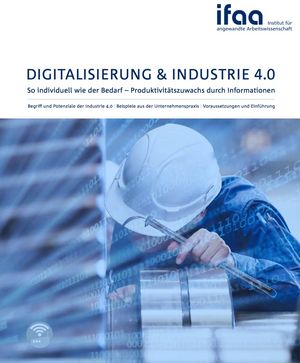KANBrief 2/17

Digitalization presents a range of new options for the shaping of work, and thus also new opportunities for occupational safety and health. This extends to all forms of work, whether primarily mental or physical. The challenge lies in exploiting the range of possibilities and in finding solutions that satisfy the needs of the company concerned.
Digitalization means that information of all kinds is handled and networked electronically, thereby permitting powerful management of the information. This enables, for example, work schedules and instructions to be prepared for specific situations in consideration of the progress of work, the product configuration, and the workers' experience. Information can be presented not only on conventional monitors, but also on smart glasses, or can be projected into the working area. These new forms of presenting information link it directly to the work object. The overhead of searching for relevant information and the corresponding workload for the workers can thereby be reduced considerably. It is important here for the actual form taken by digitalization – such as the selection of relevant information and the form in which it is presented – to meet the specific needs of the company and thus to be accepted by all parties involved.
Computer-based handling of large volumes of information permits better planning of personnel deployment. Workers' individual stress/strain situation can be considered, in addition to their availability and qualifications, when they are assigned to specific tasks. The stress/strain situation can be determined and considered in the planning process with computer support by means of worker, workplace and task profiles in accordance with established procedures, such as the key indicator methods. A system of this kind can also be used to assign certain tasks to each person at least once within a defined period, in order for a sufficient level of practice with the task and thus also familiarity with the OSH information related to it to be retained. This includes strategies for systematic rotation that ensure that regular changes occur in the stress/strain situation and that stresses are consequently better distributed among the workforce.
Digitalization enables monotonous transport tasks to be performed by driverless transport systems and tasks associated with high levels of strain by collaborative robots. The respective strengths of human beings and robots can thereby be combined selectively, and the human musculoskeletal system better protected against excessive strain and its consequences. In order for these benefits to be exploitable, collaboration must be structured such that workers regard and accept the robot as an active tool. Collisions between human beings and robots must be prevented by sensor systems and suitable control software. Design strategies such as the use of lightweight robots with low moving mass limit the forces that can arise.
The examples show that digitalization opens up numerous new possibilities (Further information: ifaa brochure, "Digitalisierung & Industrie 4.0" (pdf, in german)". Of decisive importance is that the companies recognize the opportunities and exploit the potential intelligently in the interests of occupational safety and health.
Dr.-Ing. Tim Jeske t.jeske@ifaa-mail.de
Prof. Dr.-Ing. Sascha Stowasser s.stowasser@ifaa-mail.de
Ergonomics in Industry 4.0
Digitalization gives rise to many new challenges and stresses for human beings. These must be taken into account during the structuring of work. The German standardization roadmap for Industry 4.0 (pdf), issued by DIN and DKE, outlines the issues for the humane design of work in Industry 4.0.
The newly created DIN standards committee, Ergonomics for Work structure and product design in Industry 4.0, has set itself the goal of defining standards for the design of work and products in Industry 4.0. The committee is to begin by reviewing and if necessary updating existing standards, and by identifying needs for new standardization activity. The first results are expected at the beginning of 2018.
Dr.-Ing. Patricia Stock, Deputy Chairperson of the Ergonomics for Work structure and product design in Industry 4.0 standards committee at DIN